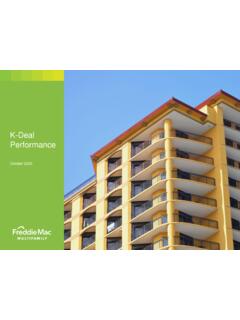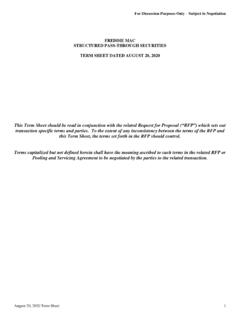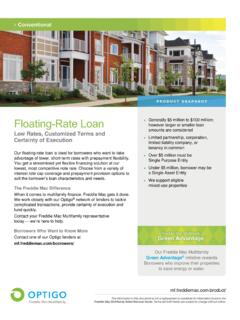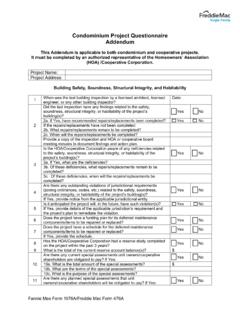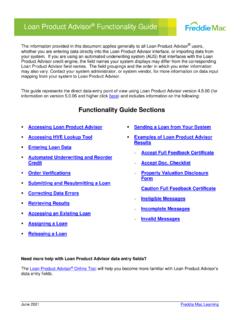Transcription of Duty to Serve - Freddie Mac
1 Freddie Mac Multifamily Duty to Serve Single-Family Rental: An Evolving Market Across the United States today there are nearly 43 million renter households million live in urban and suburban markets and million in rural Typically, rental housing is thought of as apartments: high-rise and mid-rise buildings downtown, garden apartments out in the suburbs and federally subsidized housing around the country. Indeed, over 18 million renter households live in multifamily buildings like that. But where do the other 25 million renter households live? The answer, for an overwhelming majority, is in single-family rental (SFR) homes. These homes can take many forms detached homes, townhomes and two- to four-unit properties and can be found in nearly any market in the country.
2 Indeed, in rural markets, SFRs make up 66 percent of the rental housing In fact, this market is so widespread that it amounts to a valuation of well over $4 trillion,3 compared with $ trillion for the traditional five or more unit multifamily market. Despite the size of the valuation and ubiquity of SFRs, the SFR market is not broadly understood (though increasing attention is being paid to it by investors and policymakers alike). In this paper we provide a consolidated understanding of the SFR market overall as well as its importance in rural communities as defined by the Federal Housing Finance Agency (FHFA) in the Duty to Serve (DTS) regulation. We analyze market size and demand, geographic distribution and affordability; we break out the different tiers of investors and how they access financing and investment capital; and we examine Freddie Mac's SFR pilot to date for trends, using both aggregated data and three case studies that demonstrate the breadth of SFR opportunities.
3 We find that: 1. The SFR market is the single largest segment of the rental market by valuation and households served 2. The overwhelming majority of SFRs are owned and operated by individuals or very small investors 3. There is a slow-growing middle-tier investor market with further potential for growth 4. Large-scale institutional investors are a new entry into the market, but are limited to a select few firms that own approximately 1 percent of SFRs 5. Apart from these select few institutional investors with access to the capital markets, there are limited secondary market opportunities for SFR loans with middle-tier investors that would 1. Freddie Mac tabulations of 5-Year 2016 American Communities Survey data 2 Freddie Mac tabulations of 5-Year 2016 American Communities Survey data 3 Amherst Capital estimates scaled up to include two- to four-unit properties 4 NMHC estimate found at #Apt- stock 1.
4 Freddie Mac Multifamily Duty to Serve provide liquidity and stability, and there is not a uniform set of terms and credit standards for loans on SFRs 6. Freddie Mac's pilot included both middle-tier investors and affordable homes in select large- investor portfolios and demonstrated how a secondary market infrastructure focused on SFRs affordable at 80 percent of the area median income (AMI) could be created and operated, particularly for middle-tier investors SFR Market Overview Market Size Estimates SFRs have long made up a significant portion of the national overall rental market, and the number has grown in recent years. Pre-recession data, from 1985-2005, shows that SFRs have consistently made up 10-12 million units, or 30-35 percent of the renter market Since the Great Recession, this sector has been the fastest growing segment of rental occupied households (particularly in FHFA defined High Opportunity Areas), adding 4 million rental homes, which is an increase of 35 percent over the past 10.
5 Years, according to 2016 American Community Survey (ACS) data. These estimates look only at single- unit dwellings (which today would still make up 35 percent of the rental market per 2016 ACS, recognizing the overall rental market has grown). When adding the roughly 8 million two- to four-unit properties, the total number of SFRs is approximately 23 million, or 53 percent of the total rental market. In rural markets, there are nearly 5 million SFR households, which is 66 percent of the rural rental market of million households. Figure 1: Rental Market Distribution by Housing Type by Share of Households Overall Rental Market Rural Rental Market 4%. SFR (1-4 Unit) 15% SFR (1-4 Unit). Multifamily (5+ 19% Multifamily (5+. 43% 53% Units) Units). Other Renter 66% Other Renter Occupied Occupied While the SFR market has existed for some time, scalable investment interest, and therefore research interest, has increased in recent years.
6 Despite this, there is not a uniform view of market valuation, and such valuations are dependent upon how different organizations define SFRs. For example, Amherst 5 Amherst Capital White Paper: Single-family Rental An Emerging Institutional Asset Class +SFR+Emerging+Asset+Class/9d84e0da-4a9f- 4665-9880-88a4515d9d2b 2. Freddie Mac Multifamily Duty to Serve Capital an investor in SFRs estimates market value to be approximately $ trillion based on single-unit SFRs using Census Bureau data (scaled up based on 2016 ACS to estimate million SFRs, which is more than 2016 ACS alone shows). This is smaller than their estimated $ trillion five or more unit multifamily market, but larger than the other commercial real estate (CRE) sectors: office ($ trillion), retail ($ trillion), industrial ($ trillion) and hospitality ($ trillion).
7 6 However, Amherst Capital's estimate only includes one-unit dwellings. Given that there are nearly 8 million two- to four- unit properties, which we view as part of the SFR market, the SFR market valuation is substantially larger. Using an estimated property value of approximately $200,000 based on Amherst Capital's assumptions for one-unit dwellings (~$ million), the approximately 8 million two- to four- unit properties they estimate could add an additional $ trillion to the market, bringing the total estimated valuation to $ trillion. HouseCanary, a research firm that specializes in SFRs, has a different estimate based on their analysis of public records. They focus on single-family detached homes (which would exclude townhomes and any detached two- to four-unit properties) and value the market to be $ trillion.
8 This is larger than the traditional multifamily market. Whatever the total valuation of the SFR market may be, it is important to recognize that (1) it is substantial, and (2) not all the homes have mortgage debt on them or are eligible for, or even likely to pursue, financing. Indeed, investments in this market space are not funded uniformly with mortgage debt, as is the case in the single-family ownership market or the multifamily rental market. However, if the leverage in this market were similar to the traditional multifamily market (35 percent loan -to-Value (LTV)), that would suggest a debt market of over $1 trillion to $ trillion. Debt market size should be considered with some caution, however, given that there is not the same standardization or access to credit as there is in the single-family ownership market or the multifamily rental market, and only a subset of participants is likely to make deliberate and scaled pursuit of financing whether through mortgage debt or other means.
9 This is clearer when we view the market by different segments of ownership types. SFR Market Segmentation by Ownership Types To understand the presence of different ownership types in the SFR market, we commissioned data analysis from HouseCanary. In their data, they focus on single-unit dwellings. While not the entire SFR. market, we can use this as a proxy to understand ownership type distribution generally. In this data, we see that today there are more than million different investors owning approximately 23 million units. While the SFR market has been sizable and active for decades, it is still highly fragmented, though we can see the beginning of some consolidation. At this stage several distinct stratifications of market 6 Amherst Capital White Paper: Single-family Rental An Emerging Institutional Asset Class 3.
10 Freddie Mac Multifamily Duty to Serve participants have emerged: institutional investors, middle-tier investors, small investors and very small investors, which defined in Figure 2. Figure 2: SFR Market Share by Owner Type7. Population of Estimated Market Portfolio Size SFR Properties Investors Share Institutional Investors 2,000+ 18 ~188,000 1%. Middle-Tier Investors 50-2,000 ~6,250 ~703,000 4%. Small Investors 11-50 ~88,000 ~ 7%. Very Small Investors 1-10 ~ ~ 88%. While all segments have increased their activity since 2000, very small investors easily remain the largest single participant in the market space, while institutional investors are the most financially sophisticated and able to act at considerable scale. However, the institutional participants make up only a small percentage (1 percent) of the total SFR market, and have only recently begun acquiring and operating portfolios of homes.


